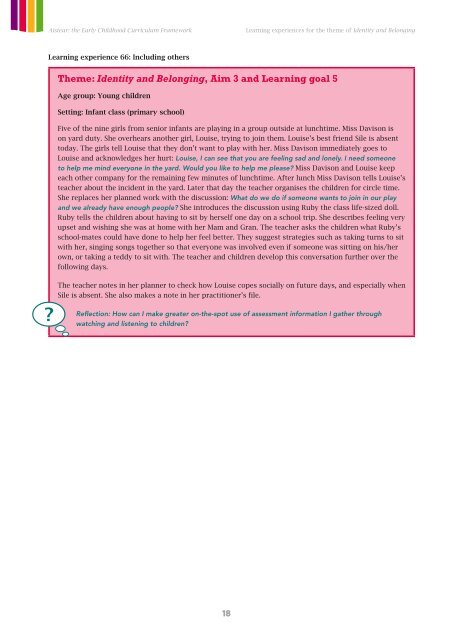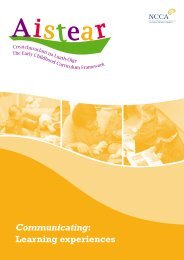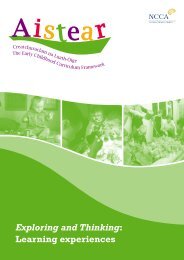Identity and Belonging: Learning experiences
Identity and Belonging: Learning experiences
Identity and Belonging: Learning experiences
Create successful ePaper yourself
Turn your PDF publications into a flip-book with our unique Google optimized e-Paper software.
Aistear: the Early Childhood Curriculum Framework<br />
<strong>Learning</strong> experience 66: Including others<br />
18<br />
<strong>Learning</strong> <strong>experiences</strong> for the theme of <strong>Identity</strong> <strong>and</strong> <strong>Belonging</strong><br />
Theme: <strong>Identity</strong> <strong>and</strong> <strong>Belonging</strong>, Aim 3 <strong>and</strong> <strong>Learning</strong> goal 5<br />
Age group: Young children<br />
Setting: Infant class (primary school)<br />
Five of the nine girls from senior infants are playing in a group outside at lunchtime. Miss Davison is<br />
on yard duty. She overhears another girl, Louise, trying to join them. Louise’s best friend Síle is absent<br />
today. The girls tell Louise that they don’t want to play with her. Miss Davison immediately goes to<br />
Louise <strong>and</strong> acknowledges her hurt: Louise, I can see that you are feeling sad <strong>and</strong> lonely. I need someone<br />
to help me mind everyone in the yard. Would you like to help me please? Miss Davison <strong>and</strong> Louise keep<br />
each other company for the remaining few minutes of lunchtime. After lunch Miss Davison tells Louise’s<br />
teacher about the incident in the yard. Later that day the teacher organises the children for circle time.<br />
She replaces her planned work with the discussion: What do we do if someone wants to join in our play<br />
<strong>and</strong> we already have enough people? She introduces the discussion using Ruby the class life-sized doll.<br />
Ruby tells the children about having to sit by herself one day on a school trip. She describes feeling very<br />
upset <strong>and</strong> wishing she was at home with her Mam <strong>and</strong> Gran. The teacher asks the children what Ruby’s<br />
school-mates could have done to help her feel better. They suggest strategies such as taking turns to sit<br />
with her, singing songs together so that everyone was involved even if someone was sitting on his/her<br />
own, or taking a teddy to sit with. The teacher <strong>and</strong> children develop this conversation further over the<br />
following days.<br />
The teacher notes in her planner to check how Louise copes socially on future days, <strong>and</strong> especially when<br />
Síle is absent. She also makes a note in her practitioner’s file.<br />
Reflection: How can I make greater on-the-spot use of assessment information I gather through<br />
watching <strong>and</strong> listening to children?





